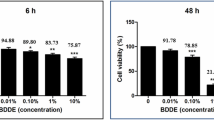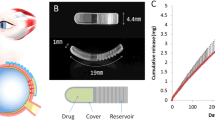Abstract
Drug-loaded hydrogel devices are emerging as an effective means of localized and sustained drug delivery for the treatment of corneal conditions and injuries. One such device uses a novel, thiolated crosslinked carboxymethylated, hyaluronic acid-based hydrogel (CMHA-S) film to deliver drug to the ocular surface upon placement into the inferior fornix of the eye. While proven to be very safe and effective, the CMHA-S film tends to dislodge in the highly-lubricated ocular environment, thereby reducing drug delivery efficiency and drug efficacy. In this study, we used a three-dimensional computational finite element model of the eye to determine the effect of geometry and surface friction on film retention in the inferior fornix, and to evaluate multiple geometrical film designs. Retention of the film was dependent on geometry and on the friction ratio of the film to the eyelid and globe. These effects were interactive. When the ratio of friction on the lid side to the globe side of the film was low, geometry played a large role in the film’s displacement. When this ratio was high, differences in displacement due to geometry were negligible. The optimal relationship of friction between the film and its eyelid-side and globe-side surfaces was found to be linear with at least 1.4 times greater friction required on the eyelid-side for immobilization. A geometry similar to a half cylinder was found to be most effective with this friction ratio in retaining the film in the inferior fornix and in contact with the globe. Other geometries will likely require other friction ratios. In summary, CMHA-S film retention can be achieved through simple modifications of geometry and manipulation of surface interaction with the eye.







Similar content being viewed by others
References
Annaidh, A. N., K. Bruyre, M. Destrade, M. D. Gilchrist, and M. Ottnio. Characterization of the anisotropic mechanical properties of excised human skin. J. Mech. Behav. Biomed. Mater. 5:139–148, 2012.
Appel, E. A., X. J. Loh, S. T. Jones, F. Biedermann, C. A. Dreiss, and O. A. Scherman. Ultrahigh-water-content supramolecular hydrogels exhibiting multistimuli responsiveness. J. Am. Chem. Soc. 134:11767–11773, 2012.
Blum, M. M., and T. C. Ovaert. Low friction hydrogel for articular cartilage repair: evaluation of mechanical and tribological properties in comparison with natural cartilage tissue. Mater. Sci. Eng. C 33(7):4377–4383, 2013.
Chang, D. F. Chapter 2 Ophthalmologic Examination. In: Asbury’s General Ophthalmology18th, edited by P. Riordan-Eva, and E. P. CunninghamVaughan. New York: The McGraw-Hill Companies, 2011.
Coats, B., M. M. Drysdale, H.-K. Lee, and B. M. Wirostko. Mechanical properties of four carboxymethylated hyaluronic acid hydrogel polymer formulations. Invest. Ophthalmol. Vis. Sci. 56:4167, 2015.
Gallagher, A. J., A. N Annaidh, K. Bruyre, and E. Al. Dynamic tensile properties of human skin. In: Proceedings of the International Research Council on the Biomechanics of Injury, 2012.
Gayet, J. C., and G. Fortier. High water content BSA-PEG hydrogel for controlled release device: evaluation of the drug release properties. J. Control. Release 38:177–184, 1996.
Gum, G. G., B. M. Wirostko, M. Rafii, V. Naageshwaran, M. Lyulkin, R. Merideth, and B. Mann. Safety assessment of a novel, cross-linked, bio-absorbable carboxymethyl hyaluronic acid (CMHA) polymer in a rabbit ocular surface model. Invest. Ophthalmol. Vis. Sci. 56(7):1297, 2015.
Hennessy, A. L., J. Katz, D. Covert, C. A. Kelly, E. P. Suan, M. A. Speicher, N. J. Sund, and A. L. Robin. A video study of drop instillation in both glaucoma and retina patients with visual impairment. Am. J. Ophthalmol. 152:982–988, 2011.
Hennessy, A. L., J. Katz, D. Covert, C. Protzko, and A. L. Robin. Videotaped evaluation of eyedrop instillation in glaucoma patients with visual impairment or moderate to severe visual field loss. Ophthalmology 117:2345–2352, 2010.
Liang, X., and S. A. Boppart. Biomechanical properties of in vivo human skin from dynamic optical coherence elastography. IEEE Trans. Biomed. Eng. 57(4):953–959, 2010.
Liu, X., H. Nanao, T. Li, and S. Mori. A study on the friction properties of PAAc hydrogel under low loads in air and water. Wear 257(7–8):665–670, 2004.
Marlow, R. S. A general first-invariant hyperelastic constitutive model. In: Constitutive Models for Rubber, pp. 157–160, 2003.
Morales, M. F., E. N. Rathbuk, R. E. Smith, and N. Pace. Studies on body composition. 2. Theoretical considerations regarding the major body tissue components, with suggestions for application to man. J. Biol. Chem. 158:677–684, 1945.
Moss, S., R. Klein, and B. Klein. Prevalence of and risk factors for dry eye syndrome. Arch. Ophthalmol. 118:1264–1268, 2000.
Quigley, H. A. Glaucoma. Lancet 377(9774):1367–1377, 2011.
Quigley, H. A., and A. T. Broman. The number of people with glaucoma worldwide in 2010 and 2020. Br. J. Ophthalmol. 90:262–267, 2006.
Rafii, M., B. Wirostko, G. G. Gum, K. Godfrey, and H.-K. Lee. Safety, tolerability, of ocular sustained-release (SR) moxifloxacin (MX) hydrogel films in New Zealand White (NZW) rabbits for corneal ulcers. Invest. Ophthalmol. Vis. Sci. 55(13):4704, 2014.
Roba, M., E. G. Duncan, G. A. Hill, N. D. Spencer, and S. G. P. Tosatti. Friction measurements on contact lenses in their operating environment. Tribol. Lett. 44:387–397, 2011.
Robin, A. L., G. D. Novack, D. W. Covert, R. S. Crockett, and T. S. Marcic. Adherence in glaucoma: objective measurements of once-daily and adjunctive medication use. Am. J. Ophthalmol. 144:533–540, 2007.
Short, B. G. Safety evaluation of ocular drug delivery formulations: techniques and practical considerations. Toxicol. Pathol. 36:49–62, 2008.
Toole, B. P. “Hyaluronan in Morphogenesis”, in Seminars in Cell & Developmental Biology. Amsterdam: Elsevier, pp. 79–87, 2001.
Von Noorden, G. K., and E. C. Campos. Physiology of the ocular movements. Binocul. Vis. Ocul. Motil. 5:53–80, 2002.
Williams, D. L., and B. K. Mann. A crosslinked HA-based hydrogel ameliorates dry eye symptoms in dogs. Int. J. Biomat. 2013. https://doi.org/10.1155/2013/460437.
Yang, G., L. Espandar, N. Mamalis, and G. D. Prestwich. A cross‐linked hyaluronan gel accelerates healing of corneal epithelial abrasion and alkali burn injuries in rabbits. Vet. Ophthalmol. 13(3):144–150, 2010.
Zarembinski, T. I., N. J. Doty, I. E. Erickson, R. Srinivas, B. M. Wirostko, and W. P. Tew. Thiolated hyaluronan-based hydrogels crosslinked using oxidized glutathione: an injectable matrix designed for ophthalmic applications. Acta Biomater. 10(1):94–103, 2014.
Acknowledgments
This material is based upon work supported by the National Science Foundation under Award Number IIP-1430921, and the Department of Defense under Award Number W81XWH-14-C-0025. Any opinions, findings, and conclusions or recommendations expressed in this abstract are those of the authors and do not necessarily reflect the views of the National Science Foundation or the Department of Defense.
Disclosures
Dr. Barbara Wirostko co-founded Jade Therapeutics Inc. and holds intellectual property relating to the use of the polymer. Additionally, she discloses a financial relationship with EyeGate Pharmaceuticals Inc. in the form of employment and stock ownership. The remaining authors have no conflicts of interest to disclose.
Author information
Authors and Affiliations
Corresponding author
Additional information
Associate Editor Joel D. Stitzel oversaw the review of this article.
Electronic supplementary material
Below is the link to the electronic supplementary material.
Rights and permissions
About this article
Cite this article
Colter, J., Wirostko, B. & Coats, B. Finite Element Design Optimization of a Hyaluronic Acid-Based Hydrogel Drug Delivery Device for Improved Retention. Ann Biomed Eng 46, 211–221 (2018). https://doi.org/10.1007/s10439-017-1962-x
Received:
Accepted:
Published:
Issue Date:
DOI: https://doi.org/10.1007/s10439-017-1962-x




